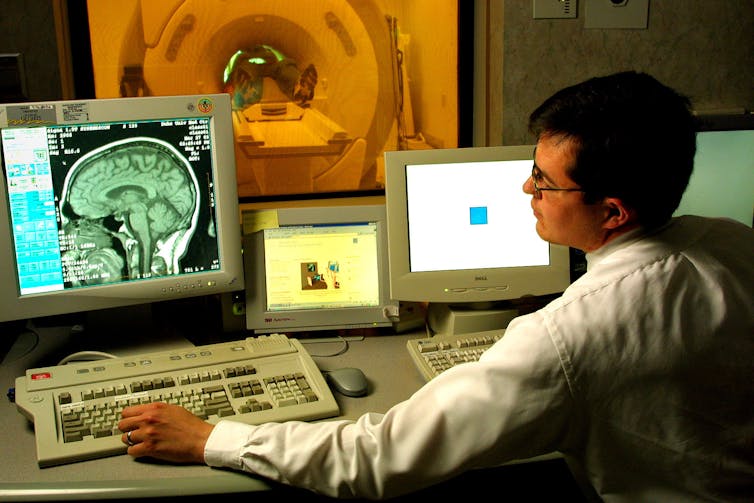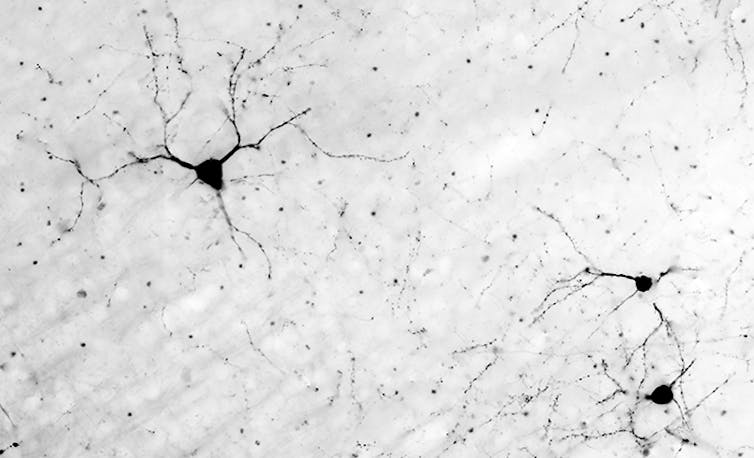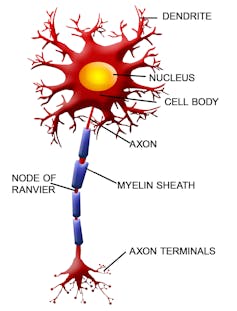How Long Does It Take a Neuron to Fire and Be Able to Fire Again?
As inquisitive beings, nosotros are constantly questioning and quantifying the speed of various things. With a fair degree of accuracy, scientists have quantified the speed of light, the speed of sound, the speed at which the earth revolves around the sunday, the speed at which hummingbirds beat their wings, the average speed of continental migrate….
These values are all well-characterized. Merely what nigh the speed of idea? Information technology'south a challenging question that's not easily accountable – but nosotros can give information technology a shot.

Showtime, some thoughts on thought
To quantify the speed of annihilation, one needs to identify its showtime and end. For our purposes, a "thought" will exist divers as the mental activities engaged from the moment sensory data is received to the moment an action is initiated. This definition necessarily excludes many experiences and processes i might consider to be "thoughts."
Here, a "thought" includes processes related to perception (determining what is in the environment and where), decision-making (determining what to do) and activity-planning (determining how to do it). The stardom between, and independence of, each of these processes is blurry. Further, each of these processes, and peradventure even their sub-components, could be considered "thoughts" on their ain. Merely we have to set our start- and endpoints somewhere to take any hope of tackling the question.
Finally, trying to identify one value for the "speed of thought" is a little like trying to identify i maximum speed for all forms of transportation, from bicycles to rockets. At that place are many different kinds of thoughts that tin vary greatly in timescale. Consider the differences betwixt elementary, speedy reactions like the sprinter deciding to run afterwards the crevice of the starting pistol (on the order of 150 milliseconds [ms]), and more complex decisions like deciding when to change lanes while driving on a highway or figuring out the appropriate strategy to solve a math problem (on the order of seconds to minutes).

Thoughts are invisible, and so what should we measure out?
Thought is ultimately an internal and very individualized process that'due south not readily appreciable. It relies on interactions beyond circuitous networks of neurons distributed throughout the peripheral and fundamental nervous systems. Researchers tin can apply imaging techniques, such every bit functional magnetic resonance imaging and electroencephalography, to encounter what areas of the nervous system are active during different idea processes, and how information flows through the nervous system. We're still a long way from reliably relating these signals to the mental events they represent, though.
Many scientists consider the best proxy mensurate of the speed or efficiency of thought processes to exist reaction time – the time from the onset of a specific signal to the moment an action is initiated. Indeed, researchers interested in assessing how fast information travels through the nervous arrangement accept used reaction time since the mid-1800s. This approach makes sense because thoughts are ultimately expressed through overt actions. Reaction fourth dimension provides an index of how efficiently someone receives and interprets sensory data, decides what to do based on that information, and plans and initiates an action based on that decision.

Neural factors involved
The time information technology takes for all thoughts to occur is ultimately shaped by the characteristics of the neurons and the networks involved. Many things influence the speed at which information flows through the organization, just three key factors are:
-
Distance – The farther signals need to travel, the longer the reaction fourth dimension is going to be. Reaction times for movements of the foot are longer than for movements of the hand, in large part because the signals traveling to and from the brain have a longer distance to embrace. This principle is readily demonstrated through reflexes (notation, however, that reflexes are responses that occur without "thought" because they do not involve neurons that engaged in conscious idea). The key ascertainment for the present purpose is that the same reflexes evoked in taller individuals tend to accept longer response times than for shorter individuals. By way of illustration, if ii couriers driving to New York leave at the same time and travel at exactly the same speed, a courier leaving from Washington, DC will always get in before one leaving from Los Angeles.
-
Neuron characteristics – The width of the neuron is of import. Signals are carried more than quickly in neurons with larger diameters than those that are narrower – a courier volition generally travel faster on wide multi-lane highways than on narrow country roads.

How much myelination a neuron has is as well important. Some nerve cells accept myelin cells that wrap around the neuron to provide a type of insulation sheath. The myelin sheath isn't completely continuous forth a neuron; there are small gaps in which the nerve jail cell is exposed. Nerve signals finer leap from exposed section to exposed section instead of traveling the full extent of the neuronal surface. So signals motility much faster in neurons that have myelin sheaths than in neurons that don't. The bulletin will get to New York sooner if it passes from cellphone belfry to cellphone tower than if the courier drives the message along each and every inch of the road. In the human context, the signals carried by the large-diameter, myelinated neurons that link the spinal cord to the muscles can travel at speeds ranging from lxx-120 meters per second (g/s) (156-270 miles per hour[mph]), while signals traveling along the same paths carried by the small-diameter, unmyelinated fibers of the pain receptors travel at speeds ranging from 0.v-2 1000/s (one.1-4.four mph). That's quite a departure!
- Complexity – Increasing the number of neurons involved in a idea means a greater absolute distance the bespeak needs to travel – which necessarily means more time. The courier from Washington, DC will take less fourth dimension to get to New York with a directly road than if she travels to Chicago and Boston along the fashion. Further, more neurons hateful more than connections. Near neurons are not in physical contact with other neurons. Instead, nigh signals are passed via neurotransmitter molecules that travel across the minor spaces between the nerve cells called synapses. This procedure takes more time (at least 0.five ms per synapse) than if the signal was continually passed within the single neuron. The message carried from Washington, DC will have less time to get to New York if one single courier does the whole route than if multiple couriers are involved, stopping and handing over the bulletin several times forth the way. In truth, fifty-fifty the "simplest" thoughts involve multiple structures and hundreds of thousands of neurons.

How quickly it can happen
It's amazing to consider that a given thought can be generated and acted on in less than 150 ms. Consider the sprinter at a starting line. The reception and perception of the crack of the starter's gun, the decision to begin running, issuing of the motility commands, and generating musculus strength to get-go running involves a network that begins in the inner ear and travels through numerous structures of the nervous system before reaching the muscles of the legs. All that can happen in literally half the time of a glimmer of an eye.
Although the time to initiate a dart start is extremely short, a variety of factors can influence it. 1 is the loudness of the auditory "get" bespeak. Although reaction time tends to subtract as the loudness of the "go" increases, there appears to exist a disquisitional signal in the range of 120-124 decibels where an additional subtract of approximately xviii ms can occur. That's because sounds this loud tin can generate the "startle" response and trigger a pre-planned sprinting response.
Researchers call up this triggered response emerges through activation of neural centers in the brain stem. These startle-elicited responses may be quicker because they involve a relatively shorter and less circuitous neural system – one that does not necessarily require the betoken to travel all the way up to the more than complex structures of the cerebral cortex. A debate could exist had hither every bit to whether or not these triggered responses are "thoughts," considering it can be questioned whether or not a truthful conclusion to act was made; just the reaction time differences of these responses illustrate the upshot of neural factors such as distance and complexity. Involuntary reflexes, too, involve shorter and simpler circuitry and tend to take less time to execute than voluntary responses.

Perceptions of our thoughts and actions
Considering how quickly they do happen, information technology'southward little wonder we often feel our thoughts and actions are nearly instantaneous. Simply it turns out nosotros're too poor judges of when our actions actually occur.
Although nosotros're aware of our thoughts and the resulting movements, an interesting dissociation has been observed between the time we call back we initiate a motion and when that motion actually starts. In studies, researchers ask volunteers to watch a 2d hand rotate effectually a clock face and to consummate a uncomplicated rapid finger or wrist movement, such equally a key press, whenever they liked. After the clock hand had completed its rotation, the people were asked to place where the hand was on the clock confront when they started their ain movement.
Surprisingly, people typically judge the onset of their motion to occur 75-100 ms prior to when it actually began. This departure cannot be accounted for simply by the time it takes for the movement commands to travel from the encephalon to the arm muscles (which is on the order of 16-25 ms). It'due south unclear exactly why this misperception occurs, only it's by and large believed that people base of operations their judgment of movement onset on the time of the decision to act and the prediction of the upcoming movement, instead of on the movement itself. These and other findings heighten important questions about the planning and control of activity and our sense of agency and control in the world – because our decision to act and our perception of when we act announced to exist distinct from when nosotros in fact do.
In sum, although quantifying a single "speed of thought" may never be possible, analyzing the time it takes to plan and complete actions provides important insights into how efficiently the nervous system completes these processes, and how changes associated with movement and cognitive disorders affect the efficiency of these mental activities.
Source: https://theconversation.com/it-feels-instantaneous-but-how-long-does-it-really-take-to-think-a-thought-42392
0 Response to "How Long Does It Take a Neuron to Fire and Be Able to Fire Again?"
Post a Comment